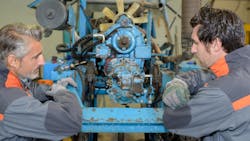Industry 5.0 Ushers in a New Era of Human-Centric Contributions to Production Processes
READ MORE: Designing a Data-Centric Industry 4.0 System
Industry 5.0 is the next step on the path to more efficient production processes. Like many other industrial sectors, in the last few years the chemical industry has focused heavily on digitalizing production plants. But now, with their cognitive skills and creativity, humans will once again play a vital role in production—backed by advancements in artificial intelligence (AI) and machine learning (ML) technologies.
In the course of Industry 4.0, many companies invested in cyber-physical systems, data processing and cloud computing to create highly efficient production environments. Production people often took a subordinate role in these concepts as reliance on machines usurped the creative significance that plant floor workers bring to the successful outcome of production procedures in process industries. Furthermore, continued development in AI opens many new possibilities for machine-human collaboration. AI is already used in R&D, for instance.
However, in production, human-machine collaboration—or, to put it another way, machine-assisted humans—is still in its infancy. But here, too, human skills remain indispensable, such as when creative solutions are required for unexpected problems or to solve global crises. Computers lack the cognitive skills to adapt quickly to ever-changing situations such as those created by the COVID-19 pandemic and subsequent restrictions on working conditions.
Enhancements in M2M Communication
Essentially, the idea behind Industry 5.0 is that production processes will be controlled by humans who are supported by efficient cognitive assistance systems. After all, it is only when more and more data is available that humans can collaborate with machines—as a team—and make necessary decisions on a solid basis. In other words, machine-to-machine and human-to-machine communication must be extended with digitally supported, integrated communication between the workers.
The chemical industry will benefit from this approach in many ways, such as with safer processes, increased productivity and resource efficiency, and opportunities to pursue an economically viable switch to carbon neutrality. Increasingly complex workflow and systems are required to achieve these goals. These days, enormous data volumes are available to manage these issues. As long as everything runs according to plan, this is not a problem. But when things don’t turn out as expected, problems can arise that, in most cases, require human intervention. To make the necessary decisions quickly, people don’t need a flood of information, just the right information. That is the key task of cognitive assistance systems.
Implementation in One or Several Steps
What must companies do to implement Industry 5.0 in their production processes? They must develop a new understanding of human-machine collaboration; in other words, enable a greater extent of employee knowledge to be included in a digital system rather than simply using people as a monitoring tool for equipment or machinery. While a certain level of automation must exist, it is not necessary for a complete Industry 4.0 concept to have been implemented. Depending on the initial situation, companies can either start immediately with a comprehensive 5.0 concept or proceed in stages.
Regardless of the automation level, there is a lot of knowledge retained by employees. Routines that have more or less become second-nature to them are especially suitable for being digitalized. One example of this is at shift handover. No matter how often this has been done in the past, things will not always run smoothly with the usual analog procedure. Various studies shown that 50% of all mistakes in plants and factories are made in the first 30 min. after a shift change. And mistakes can have serious consequences, especially in the chemical industry.
Digitalizing Knowledge and Communication
Although there is already software that supports personnel at shift handover on the market, most of these only fulfill Industry 4.0 requirements. In the future, it will be important to network the cyber-physical and human levels to a greater extent, not only at shift handover but also, for example, with OEE (Overall Equipment Effectiveness) reporting. To do this, the knowledge and communication of all concerned, such as rotating and day-shift teams, production and site managers, and the company’s top management, must be largely digitalized to ensure complete transparency for everyone.
READ MORE: What Industry 4.0 Means for Product Management
Shift-handover management is one approach that can be used to achieve this. It ensures clearly structured processes in operational control and company communication and can be used regardless of the extent to which Industry 4.0 concepts are implemented. Information from every point of a production process can be captured, analyzed and integrated into other company-critical systems, such as ERP (Enterprise Resource Planning), maintenance management (i.e., SAP) and production planning.
User Acceptance Through Local Adaptation
Companies can use shift-handover management software to define uniform standards for the respective processes. This gives them a complete overview of routine actions, special events and plant capacity that can be easily reviewed. In short, it is a cockpit for plant management.
The successful introduction of global concepts that have a significant effect on operational procedures depends largely on the degree of user acceptance. Because few plants in the chemical industry are exactly the same, it is essential for company-wide standards to be adapted. The workers on site know best how operational reality needs to be mapped. Because most of the workers are not IT experts, the software provides a configuration environment that lets applications be modified via a graphical user interface without any programming.
Comprehensive Plant Process Management
Shift-handover management can provide functionality designed precisely to suit the human side of the processes and the operational organization. This enables a high level of interoperability between smart machines, other systems and the workers. With the ability to integrate company-wide standards and allow local modifications, the shift-handover software can be operated for decades.
Digitalized communication through shift-handover management not only enables Industry 5.0-compatible shift changes and morning meetings but can also support effective issue management. In other words, production personnel can quickly recognize special events, such as a malfunction in the process, a contaminant leak or an accident, and communicate it to all levels in the company. Key Performance Indicators (KPIs) can also be routed to external systems or be analyzed directly in the software.
Mobile Networking of Shift Personnel
Additional capabilities for digital communication are to increase the safety of routine tasks and support compliance management. During their regular inspections, workers can download lists of tasks and specific actions to their mobile devices and report the results to the plant operators in the control room. Deviations can be documented with photos and displayed in the shift report or discussed at the morning meeting. Following this, the information is sent to the person responsible for corrective actions.
READ MORE: Yes, Industry 5.0 is Already on the Horizon
Digitalized communication is designed to increase asset performance. To do this, machine productivity is measured exactly, and performance losses and their causes are also recognized. This information is available not only in production but can be aggregated across all levels of the company through to top management. To ensure shift employees always have an eye on product quality, data can be enabled and displayed from laboratory systems and the like. In the case of escalating deviations, workers can either be instructed what to do or a message can be sent to an external system.
Conclusion and Outlook
Industry 5.0 allows the skills and creativity of people to be used to increase the safety and productivity of the processes. AI-supported technologies will provide support and, with extensive networking, enable the highest possible level of interaction between humans and machines and also between employees. Shift personnel in chemical production plants will continue to work 24/7 but will have to carry out fewer routine tasks. This gives the industry an opportunity to create new, appealing jobs that provide more value to the organization. In the future, employees will also delegate more complex tasks to machines, which will then become as natural as when we say “Alexa, play some music.” But one thing will probably never change: Success or failure will ultimately depend on humans, not machines.
Andreas Eschbach is CEO and founder, eschbach North America Inc.

